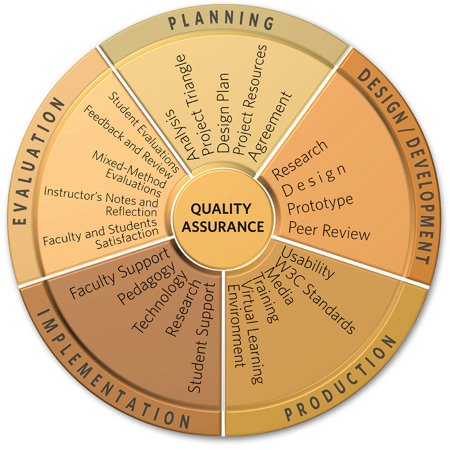Design Quality OnlineCourse
| Home Page | Planning | Design and Development | Production | Implementation | Evaluation |
|---|
Designing for a Quality Online Course

In this online resource, the model used for course development is a project team-based structure.
The framework still can be used by those who have a "lone ranger" approach to the course development process. All of the resources can be used as they are and are in development, based on the feedback received and ongoing research in the field. You can evaluate/modify your courses using the checklists provided in this module.
PDPIE Framework: Online Course Development Quality Cycle
The main phases of online course development cycle, in majority of instructional design models, follow ADDIE model. In PDPIE framework, the course development happens in five Phases including Planning, Design/Development, Production, Implementation, and Evaluation. In each phase given in the menu above and presented in the image, basic steps are illustrated and key/promising elements and required documents for a quality course are shared. This framework is developed from an instructional designer's perspective; therefore, different steps discussed in each phase are focused on this role's tasks. The goals of this resource are to assist you to:
- Build on your current instructional design skills/strategies and learn about online course development cycle.
- Investigate and identify various effective promising practices and checklists for online course development and delivery.
Below are two checklists; one for course development phases and one for quality elements:
Online Course Quality Checklist
Online Course Development Checklist
Massive Open Online Course (MOOC)
Massive Open Online Course (MOOC) is added to this resource as the recent development in the area of online learning carrying three key characteristics:
1) low cost or no cost,
2) open access
3) large-scale participation
Online Learning: Course Development Team
The organizational model for online course development presented here is a project team-based structure consisting of course author/instructor, instructional designers/project managers, web programmers/designers, librarian, graphic designers, multi-media producers and copyright office.
- Course Author: the course author (most of the time the course instructor) is responsible for developing the content for the course, which includes defining the learning outcomes, assessments and learning activities, as well as developing the lessons and readings. They are responsible for providing subject expertise on course content, developing instructional materials and original content drawn from their own research and experience as an instructor.
- Instructional Designer: the Instructional Designer works closely with the faculty member on the design, development, implementation and evaluation of an online or blended learning course. Within this context , the instructional designer works closely with the course author on the design and through all the course development phases to set learning outcomes (or objectives), implement interactive activities such as discussion boards (forums), chats, wikis and blogs, develop course assessments/assignments and introduce/explore/select learning technologies that support learning. They work with all the team members to ensure that the team is appropriately informed and resourced and monitors the budget and progress of the project based on the schedule agreed on by the development team. If there is no instructional designer assigned to a project, the course instructor works on all these tasks on his/her own.
- Web Programmer: Web programmer works with instructional designers and faculty to design, develop and deliver online courses, using different various content management systems and technologies. Web programmer works closely with ID and faculty to develop the overall structure and organization of the course online based on the World Wide Web Consortium (W3C) Standards[1] (creating the html files, uploading the files, setting up the assessment and other technologies and tools).
- Graphic Designer: Graphic designer creates images, charts, and 3Ds and animated images for multimedia, projects and courses according to the W3C standards.
- Librarian: Subject librarian joins the team to advise on selection of textbooks, available articles and supplementary readings. S/he provides expertise on bringing latest research and articles related to the field/subject of the course.
- Media Producer: Media producer assists to develop videos, audios, animation, interactive activities/videos, and simulation with full compliance with the W3C guidelines.
- Copyright Office: Copyright office at UBC provides one-on-one support with questions about copyright in teaching and scholarly publishing and help obtaining permission to use copyrighted materials in your online or blended course.
References
- ↑ The World Wide Web Consortium. Available at: http://www.w3.org/standards/
License
Please provide your comments and feedback to Afsaneh Sharif at afsaneh.sharif@ubc.ca.
|
|